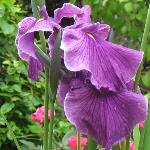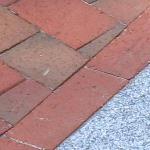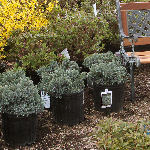Planting & Cultural Information |
General Planting & Care
Plants are living & perishable - handle with care!! Dig a hole twice as wide as but NO deeper than the size of the plant’s root - ball. Save this soil. Remove the pot (if your plant is in one) but do not remove any burlap or string from B&B plants. If there is white elastic mesh around the root -ball, remove this. *** Please take note of any plastic twine around the neck of the tree.This should be removed a year after planting so it doesn't girdle the tree. For potted plants, loosen root - ball with your hands if it is root - bound, or make shallow vertical cuts in root - ball. Place plant in hole & check that the top of the root - ball (bottom of trunk flare) is at ground level (not below). Amend saved soil with compost which will aid plant in establishing itself. Place amended soil back into hole around root - ball, firming as you go. When half full, water well. Fill hole the rest of the way with amended soil, again firming as you go. Build a water well around the base of plant forming a lip at the edge. Fill this well with water, then mulch. Stake trees only if necessary!! We can direct you in how to do this. Water every 2 - 5 days using your own discretion, as soil type and environmental conditions vary greatly. When watering, soak the soil thoroughly - do not use a lawn sprinkler as this only waters the top inch or so of soil.
|
|
Clematis Care & Pruning
Clematis like their feet (roots) to be shaded-by mulch or by low-growing plants and like their heads (tops) to be in sun. Pruning-Group 1-C. montana var. rubens-requires little pruning; prune immediately after flowering. Group 3-Gypsy Queen, Polish Spirit, Ville de Lyon, Warsaw Nike-remove all previous season's growth down to 2.5' from the ground in late February or early March.
|
|
Azalea & Rhododendron Care
*Please note that this section also pertains to Andromeda & Mt. Laurel*
All of these plants prefer being planted in some shade, such as the eastern or northeastern side of a house. Full sun will scorch the plants and cause drying - out issues in winter, as well as predispose them to developing lace bugs. These plants prefer moist, well - drained soil and an acidic pH of less than 6.0. Hollytone is a great acidifying fertilizer for these plants. This fertilizer can also be used if plants planted along a foundation start to yellow. Any pruning must be done within 2 - 3 weeks of the flowers dying as these plants are already forming next year’s flowers. To prune, only cut back to first set of leaves on a stem.
|
|
Ornamental Grass Care
-
Most of the ornamental grasses we sell are warm - season grasses, therefore they will be a bit slow to start in spring. Be patient & do not assume that they are dead!! Exceptions include the Blue Oat Grass.
If grass has been left up for winter interest, early spring is the time to cut back the stems to about 4” in height. All grasses re - grow from the crown (the soil line) and if these dead stems are not removed you’ll have 5’ tall sticks in your grass. It seems that leaving the dead stems up for winter also protects the crown from winter damage. Most of our grasses are rather drought - tolerant* but will need to be watered for the first year after planting. *Please note the definition of drought - tolerant - a plant that, ONCE established (which can take a year), will tolerate prolonged dry periods with little moisture. Grasses can be dug up and divided every 3 or so years depending on their growth rate. The roots can be cut apart with a knife. |
|
Hydrangea Care
Mophead (i.e. Nikko Blue) and Lacecap Hydrangea flower colors are dependent on the pH of your soil. For the flower to be blue the pH must be less than 6.0 and to stay pink the soil pH must be greater than 7.0. Hollytone is the safest acidifying fertilizer you can use. Lime (dolomitic lime) is used to raise the pH. Test the soil pH before each addition of these agents. Mopheads & Lacecaps mostly bloom on older stems & thus need to be pruned right after the flowers fade. Only prune down to the first set of leaves. Next year’s flower buds are already forming at that junction. Sometimes they will bloom on some newer stems but not as much. Nikkos are especially prone to late spring frosts and therefore may lose some of that year’s flowers. A new exception to these 'rules' is the Endless Summer Hydrangea, which is supposed to bloom on new wood. Prune Annabelles & Paniculatas (PG) in early spring; prune Oakleaf after flowering. The color of Annabelle, PG and other white - flowered Hydrangeas can not be changed by changing the soil pH!!
|







